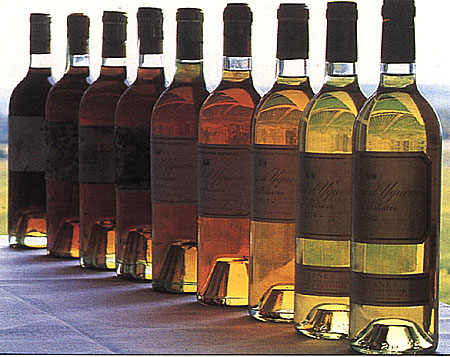
WineRegionsOld WorldFranceBordeauxGraves
SAUTERNES AND BARSAC
These are not only the world's most luscious wines, but also its most complex.
Chateau d'Yquem is by far the best regonized and celebrated wine of Sauternes.
The battle for second place is always between the soft, luscious style of
Suduiraut, and the inch, powerful character of Rieussec, with Climens, Nairac
and the non-classified growths of Gilette and de Fargues in close pursuit.
Guiraud has the potential to go right to the top of this pack, and with
so many chateaux suddenly and seriously improving, they could all end up
chasing each other for the number two spot.

The "noble rot'
Yquem might be the ultimate, but many other great wines are made in these
two small areas tucked away in the Bordeaux backwaters. What gives all of
these wines their hallmark of complexity is, literally a lot of rot, namely
"noble rot", or the fungal growth botrytis cinerea. The low lying,
undulating hills of Sauternes and, to a lesser extent, of Barsac, together
with a naturally warm but humid climate, provide a natural breeding ground
for botrytis, the spores of which are indigenous to the area. These spores
remain dormant in the vineyard soil and on vine bark until they are activated
by suitable atmospheric conditions. These conditions are alternate moisture
and heat; the early morning mist is followed, day after day by hot mid morning
autumn sunshine. The spores latch on to the skin of each grape, replacing
its structure with a fungal growth and feeding on moisture from within the
grape. They also devour five sixths of the grape's acidity and one-third
of its sugar, but as the amount of water consumed is between one-half and
two-thirds, the effect is to concentrate the juice into a sticky, sugar-rich
pulp. A healthy ripe grape with a potential of 13 per cent alcohol is thus
converted into a mangy looking mess with a potential of between 17.5 percent
and 26 percent. The spread of botrytis through a vineyard is neither orderly,
nor regular, and the harvest may take as long as ten weeks to complete,
with the pickers making various sorties, or tries, through the vineyard.
On each try, only the affected grapes should be picked, but care must be
taken to leave some rot on each bunch to facilitate its spread.
The longer the growers await the miraculous "noble rot", which
only comes in sufficient and unhindered strength about three years in ten,
the more the vines are prone to the ravages of frost, snow, hail and rain,
any or all of which could destroy an entire crop. The viticultural methods
of Sauternes and Barsac are the most labor intensive of any region. The
yield is very low, officially a maximum of 25 hectolitres per hectare (112
cases per acre) about half that in the Medoc, and the levels achieved in
the best chateaux are much lower, around 15-20 hectolitres per hectare (67-90
cases per acre). At Yquem it is even less, the equivalent of one glass per
vine. On top of all this, the vinification is, at the very least, difficult
to handle and maturation of a fine sweet wine demands a good proportion
of very expensive new oak.